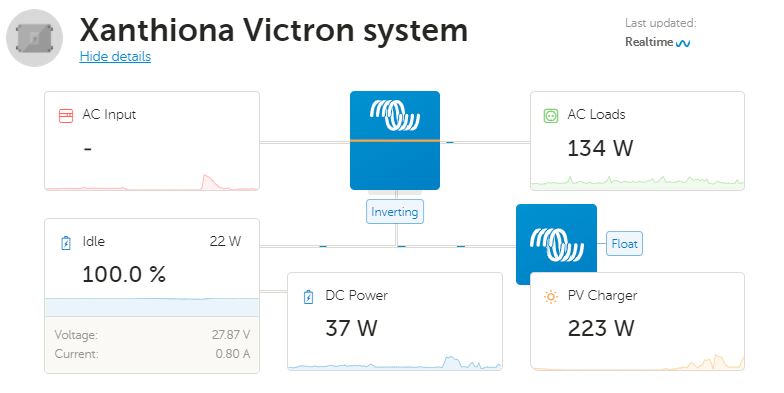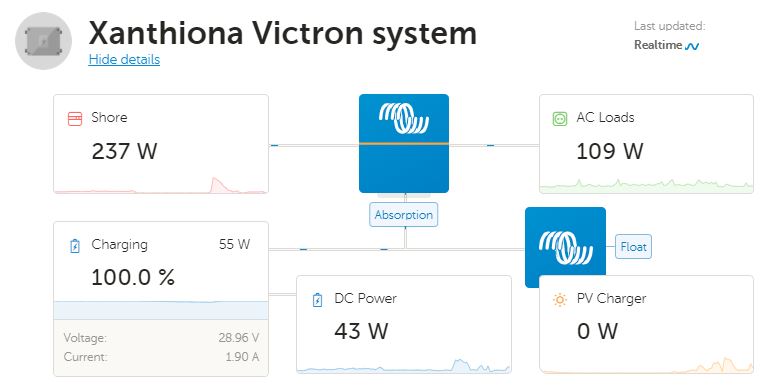Dear all,
I am struggling with the correct settings of the Venus GX, Quattro and MPPT to maximise the use of the solar panels. System setup:-Quattro 24/8000-720 Ah tubular plate battery (12 x 2 V cells)
-Venus GX, DVCC enabled (charge current limit at 70A, STS, SCS and SVS enabled)
-2 x LG Neon R 370 Wp solar panel (total 740 Wp)
-MPPT 100/30
I have been experimenting with the DVCC setting of the Venus GX and the configuration of the Quattro in order to maximise the output of the solar panels. So far I have concluded that when I use an assistant in the Quattro configuration that switches of the AC in, then I get a lot more out the solar panels (see screenshot 1 below). When I do not use the assistant and AC in is connected to shore, (see screenshot 2), solar output sometimes even goes to 0, but mostly around 50 W.
I have read and studied all manuals (Quattro, GX, MPPT) in english and dutch, read approx. 100 postings on the community site on similar subjects, but I still cannot find the best configuration for the Quattro and the DVCC setting.
The following is stated in the GX manual:
-" Enabling DVCC changes a GX device from a passive monitor into an active controller"
-" DVCC offers features such as a configurable system wide charge current limit, where the GX device actively limits the inverter/charger in case the solar chargers are already charging at full power."
-"Limit charge current. This is a user-configurable maximum charge current setting. It works across the whole system. MPPT Solar Chargers are automatically prioritized over the mains/generator."
My expectation was that by enabling DVCC with the charge current limit and STS,SCS and SVS enabled, that the GX would make sure maximum output comes from the solar panels and the output from the Quattro is reduced. But as shown by the screenshots this is not happening.
The only way that I was able to maximise the output from the solar panels was by using an assistant that switches off AC in of the Quattro, when the batteries are above SoC of 70 %. Once below 70 % it then reconnects AC in and batteries get charged to 90 %. After that AC in switches off again and solar panels take over the charging. This will work on sunny days, but a longer time without a lot of sun results in a lot of shore power being used to bring the batteries every time back from 70 to 90 %. Over a longer period of time this seems to use more electricity then letting the Quattro keep the batteries at 100 % continuously.
After having read more or less similar posts, I have the impression that if I lower the absorption and float voltage of the Quattro with say 0.2 V that the charging should behave as expected: solar charging takes priority and charge with high watts and Quattro charging is reduced. So I changed the absorption and float voltage of the Quattro with 0.2 V, but I still do not actually see the charging behave as expected, see screenshots (screenshot 1 with assistant, 2 without).
Any suggestion/help is appreciated, because I want to lower the shore power electricity bill and use as much solar power as available.
Thanks.


